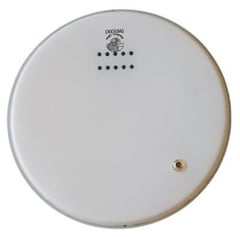 Magnetic pickups are nothing new to the millions of guitarists in the world. Their dependability and versatility is undisputed. Finally - this style of pickup, with all its potential, has been applied to the acoustic banjo.
Magnetic pickups are nothing new to the millions of guitarists in the world. Their dependability and versatility is undisputed. Finally - this style of pickup, with all its potential, has been applied to the acoustic banjo.
The Kavanjo Pickup System is a magnetic pickup based on a humbucker style pickup. Just like guitarists, the Kavanjo helps the banjoist finally compete in live venues previously reserved for higher volume instruments. It does this while maintaining the banjo's unique sound, giving banjo players the confidence to tackle outside venues and large concert halls with a tool that has been lacking for decades. It provides studio musicians an infinite number of sound possibilities and offers those of us that will never 'play out' hours of entertainment in the privacy of our own homes.
I have compiled a handful of commonly asked questions to help with getting the most out of your Kavanjo Pickup System, as well as a few good user tips.
Q. What is a magnetic pickup?
A. The two basic components of this type of a pickup are the 'coil' and the 'magnet'.
The coil is a bobbin, wrapped thousands of times with a coated copper known as 'magnetic copper wire'. This wire is just a little thicker than our hair and is wound on special machines to insure precise distribution of the wire throughout the bobbin.
The magnets on the other hand, create an environment such that when the string is plucked, energy from the north and south poles of the magnetic field are disrupted. These waves are then "picked up" in the coil(s) which registers them as an electrical signal or current. This signal is sent down an instrument cable to the amplifier, guitar amp, mixing board, DI, or computer.
Tip: When running into a computer, you will first be required to convert the signal from Analogue to Digital.
Q. What strings are best to use?
A. With this style of pickup, you will want to use Nickel (steel) strings. Nylon strings will not register a signal at all, for they lack any metal. Stainless steel strings lack enough iron in them to create a good disruption in the magnetic field.
Q. Why use electric guitar strings on my 6 string banjo?
A. Phosphor/bronze strings (commonly used on acoustic guitars) lack iron in their exterior, which is crucial for a hearty signal. Do to this; the magnetic pickup only registers the core of this type of string, and not the exterior winds. When using nickel guitar strings the entire string is 'picked up', giving you a strong and even sound throughout.

Q. Is there an ideal gauge of string?
A. String gauges can be as personal as what picks you prefer. Depending on the instrument's scale, tightness of the head, bridge height, coordinator rod, and tension rod strength, the variables are plenty. I suggest trying lighter gauge strings on your instrument until you as a player start to demand more out of the string thickness. Arriving at the ideal string gauge for your playing style and instrument can take some time.
Q. How tight can I make a banjo head that has a Kavanjo on it?
A. The Mylar plastic that makes up the banjo head is so strong on a molecular level, you can bring it up to whatever tension you prefer. Remember your head tension will directly affect your bridge height in relationship to the strings. The bridge height will affect your strings 'action' which is the distance that the string stands away from the frets. Installing a banjo head with the proper diameter and crown height is one of the most important details.
For example, Deering banjos (2006 to current) use a medium crown 11" head with the exception of Goodtime banjos which use a high crown 11" head. We will investigate more about, head types and styles, and their effect on tonality in future Q&A's.
Tip: Having your banjo head tuned appropriately for your banjo is a must if you want to get the most out of your instrument with the least amount of effort.
Q. What should I run my Kavanjo through?
A. You can run the Kavanjo through any amp, acoustic or electric; any D.I. box, preferably with some form of volume control. Especially on stage it is important to have control of your own volume. If you have never played through an amplifier, it can take some getting used to. There is a small disconnect with hearing the sound coming from a different source or place in the room in comparison to the acoustic banjo you are holding in front of you. If playing in a smaller space try balancing the acoustic sound with the amplified sound. Place your amplifier slightly behind you on the floor if you prefer sitting, or tilt it back like a monitor wedge if standing. Don't be afraid to experiment! If you play with a band that has a loud stage volume, try positioning yourself and your amp to create a personal zone. In my opinion, if you can't hear yourself nothing else matters.
If we as banjo players want to compete at the same stage volume with guitars and basses who bring their amps to the gig, we need to get out of the mind frame of just showing up only with our instrument, hoping things will magically come together in the mix from the sound board. With an amp, big or small you now have control over your immediate sound,which in my experience is the most important extension to your playing.
When one cannot properly hear their instrument it is impossible to play relaxed. Prior to playing with an amplifier, I would play harder than usual to compensate for not being able to hear well. I found myself making silly mistakes and being completely frustrated with my performance. I could see my fingers playing, but did not know how my playing was mixing with the other instruments for me or the audience.
Tip: If playing a 5 string banjo with metal finger picks, you might notice a tiny metallic clicking sound while playing. This is normally the result of the ground wire placement. When connecting the ground wire from the Kavanjo’s output jack, to your banjo, make sure it touches a part of the metal such as the tail piece, or cast flange (which holds the tail piece). Both have connection with the strings, which is what you are after. Some banjo models' coordinator rods terminate into the wood rim. Connecting to them would not give you a full ground because they do not make it to the string or arm rest.
Q. What type of Amplifier do I need?
A. There are two routes you can go with amps, solid state or tube. Tube amps are said to have a warmer tone due to the fact the electricity is conditioned through a vacuum tube(s) in the pre amp section and the main power is conditioned with tubes as well. Solid state amps can be half the price of a tube amp and the Kavanjo sounds great through this style of amplifier. A 25-35 watt amp is a good place to start and is the equivalent of having your own little monitor on stage with you. You do want an amp with a some headroom, so in a practice setting the volume knob might be set at 2-3 but in a live show set between 4-7. Turning up to 9-10 on most amps will overdrive your signal and give you distortion, which in some styles of music like hard rock is great. But if you want a clean banjo sound get some "headroom".
Tip:
If you have a really good sound person and mics are not in short supply, have them set a mic right in front of you at waist level that you can step up to for the more acoustic moments, leaving the Kavanjo through the amp as your live sounds' foundation. The sound person can mic the amp or take a direct line (DI) from it.
I suggest going to a music store that specializes in electric and acoustic guitars and play through as many amps as possible to find the one YOU like. Electric guitar amps or acoustic guitar amp, you won't know which is best for you till you play through them. Take a bandmate to get a second opinion!
Sound:
Here is an order of events that create the amplified banjo sound:
1. Your fingers pluck or strum the strings.
2. The banjo strings vibrate.
3. The pickup is energized and sends an electronic current to the output jack.
4. The instrument cable relays that electric signal to the amplifier and out of its speaker.
5. The sound waves travel through the air and back to our ears.
IN CONCLUSION:
John Kavanaugh has been working with Deering Banjo Company for over 5 years. His banjo pickup system is currently used by countless musicians around the world including mainstream artists/bands like Taylor Swift, Mumford and Sons, Elton John Band, and others. Feel free to email us at info@deeringbanjos.com if you have any further questions regarding the Kavanjo pickup system.
Changing your banjo strings is one of the easiest and best ways to bring the tone of your banjo back to life. One of the most common questions we hear is how...
It is generally accepted that the first banjos were constructed without a tone ring. They were built with a round rim made of wood with a skin head (just like...
Learn how to properly adjust the action of your banjo via the coordinator rods. Deering's Quality Control Manager Chad Kopotic will take you through this step...
This is the rebroadcast of the 8th episode of our series Deering Tech Live. In this week's episode, something a little different. Greg Deering, the cofounder...
3733 Kenora Dr.
Spring Valley, CA 91977
COMMENTS